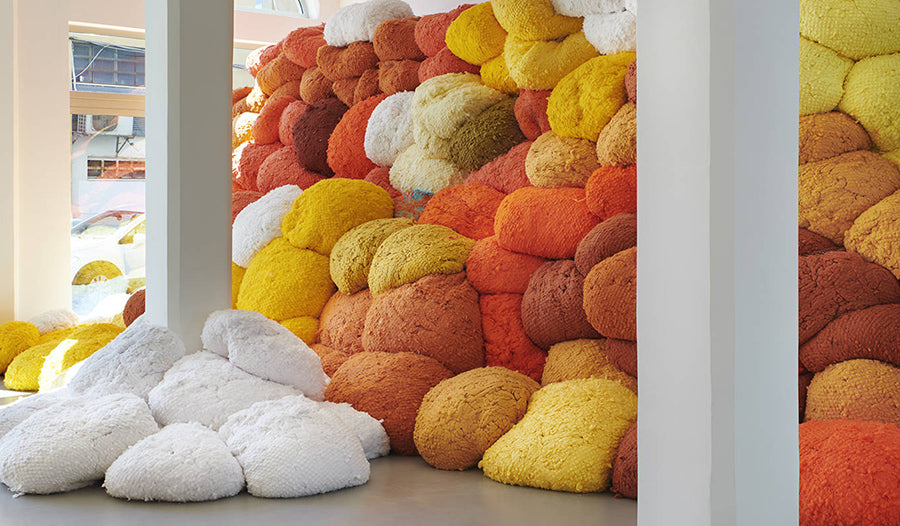
OFF THE GRID
It is difficult to imagine the place of textiles in contemporary art without Sheila Hicks. She has vastly advanced the medium and played a vital role in the propagation and legacy of textile arts. Now eighty-seven, Hicks, originally from Nebraska, is renowned for her experimental and colourful textile installations, each holding a deeply personal message. She has thrived beyond the conventions of textile-making, refusing to limit weaving to the realm of decorative art, and has transformed it into a sensual and interactive experience.

Hicks’ education at the Yale School of Art was the foundation and source of her inspiration. The combination of Bauhaus painting classes with Josef Albers and courses led by George Kubler, an expert in pre-Colombian art, shaped Hicks’ aesthetic. She still characterises Kubler’s seminars as her most memorable academic experience: ‘I began teaching myself how to weave because I was interested in how the pre-Incas structured thought with threads, with lines...They were engineering in three dimensions and creating their own materials.’ Using recycled painting stretchers, Hicks constructed her own improvised backstrap loom and set herself a mission to explore the structures and languages of pre-Columbian textiles.
Weaving, stamping, assembling, twisting and knotting, Hicks has embraced many voices and techniques in textiles throughout her sixty-year career. Her works have incorporated everyday objects such as elastic bands, shirt collars, shoe laces and noodles, as well as natural materials including razor clam shells and slabs of slate. It was, however, Hicks’ travels that were pivotal in shaping her distinctive practice.

In 1957, she was awarded a scholarship to Chile, and a few years later she moved to Guerrero in Mexico. Initially intending to make a documentary about Félix Candela’s experimental architecture, Hicks quickly turned to textiles and met regularly with local artisans. She came to work with these Indigenous communities, reinterpreting and producing textiles from native techniques. Hicks was especially fascinated by the use of natural materials in Mexico, a choice that continues to influence her today. Her work became increasingly three dimentional and played with local colours, like the Mexican cochineal used in her piece Solferino Tacubaya (1961).
An insatiable curiosity has been the driving force of her extensive career. The scrapbooks she has kept since her first trip to Chile in 1957 are filled with lengthy records of textile-making and speak for the breadth of her research. At the heart of Hicks’ work is haptic learning and collaboration. She strives to foster important relationships with the local artisans she meets and consults them for guidance. By adopting Indigenous weaving practices in their country of origin, whether Mexican or Saudi Arabian, Hicks always brings these communities and cultural narratives to the forefront, assuring their long overdue space in textile history.

More recently, Hicks’ work has taken the form of large free-standing pieces. Traces of Hicks’ ainting studies seep into her new sculptures by way of brush stroke textures and outrageous perspectives. These playful pieces are tactile in their shapes, silhouettes and unconventional materials, and some gallery visitors have even been invited to touch the work. The overwhelming scale of these abstract textiles allows the viewer a childlike sense of wonder as the threads transform into environments in themselves. To this day, Hicks uses the same pocket loom she has carried since she was a student. With this, she creates minimes, small intricate weavings on which she trials new techniques before producing larger versions...
--
Sheila Hicks: Off Grid will take place at The Hepworth Wakefield, Yorkshire from 7 April - 25 September.
Excerpt from the article Off the Grid: Sheila Hicks weaves her magic, written by Lydia Caston. Find out how to read the rest of the article in Issue 105 Checks & Stripes.


2 comments
increíble Belleza y trabajo con laboriosidad
colores y texturas mágicos
Extraordinario y monumental trabajo
Inspiradora mujer, le admiro mucho
Superb inspiring textiles and love blue shelves library